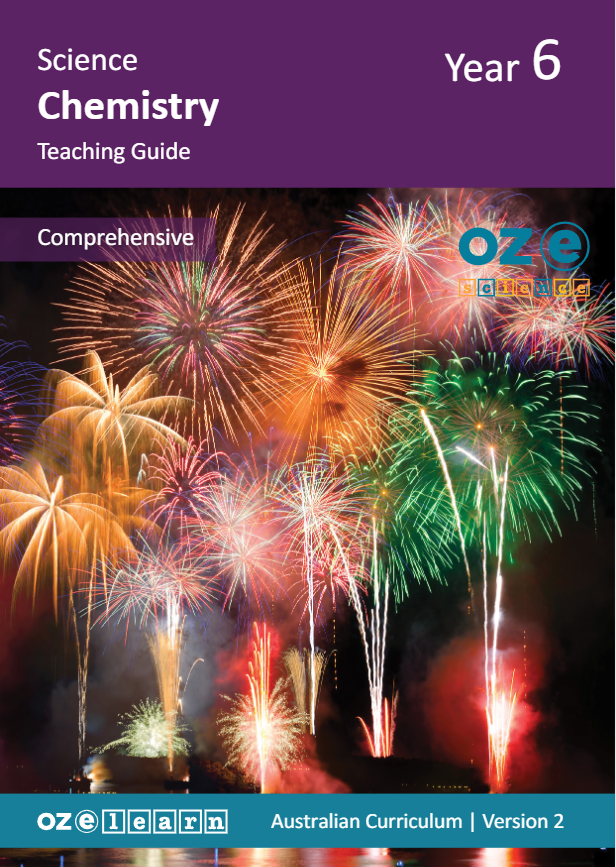Oz-e-science

Teaching resources
Extra resources
- Explain that all matter is made up of atoms.
- Describe the structure of an atom.
- Represent the structure of an atom.
- Explain what molecules and compounds are.
- Compare simple molecules with compound molecules.
- Represent the structure of a compound molecule.
- Explain how iron was formed. Represent the galactic story of iron.
- Explain what electrons are.
- Describe where electrons can be found in different elements.
- Represent the number of electrons in an electron game.
- Explain how atoms can give or take electrons from other atoms.
- Describe how giving and taking electrons leads to atoms bonding.
- Represent how atoms bond in the electron bonding game.
- Explain why some atoms are more reactive than others.
- Sort atoms by their reactivity.
- Describe how objects can be sorted into tables by their properties.
- Describe how elements are sorted into the Periodic Table of Elements.
- Sort elements into the Periodic Table by their properties.
- Predict where elements might be placed in the Periodic Table.
- Explain what happens when a material physically changed.
- Describe what happens to the molecules when physical change occurs.
- Predict what happens when slime is physically changed.
- Explain what happens when a material is physically recycled.
- Describe which materials can be physically recycled.
- Sequence the steps of physically recycling materials.
- Explain what happens when a material chemically changes.
- Describe what happens to the molecules when chemical change occurs.
- Predict what happens in an everyday chemical reaction.
- Explain what happens when a material is chemically recycled.
- Describe which materials can be chemically recycled.
- Sequence the steps of chemically recycling materials.
- Ask a question, develop a hypothesis, predict an outcome for an experiment, and observe to understand which liquids can make iron rust.
- Observe, evaluate and explain the experiment to understand which liquids can make iron rust.
- Report findings from investigation and communicate them to an audience.
In Lessons 1 to 15, students learn about:
- The smallest particles called atoms and what they are made of.
- Molecules.
- How iron was formed.
- Electrons.
- How some atoms share electrons and bond together.
- Some atoms that are highly reactive and others that are happy as they are.
- How objects and chemical elements can be sorted by their physical properties.
- How elements are sorted into the Periodic Table of Elements by their properties.
- The physical changes of materials.
- How physical changes can be used in recycling materials.
- the chemical changes of materials.
- How chemical changes can be used in recycling materials
- How to conduct an experiment using the scientific method
- Conducting the rusting iron experiment
- How to present the findings of the rusting experiment.
Progress tests
Progress tests are conducted after every second lesson, allowing teachers to monitor student understanding of the concepts taught over the past two lessons and to identify where reteaching is needed.
The Teaching Guide contains the testing questions, and the Student Workbook has a section where students write their answers and score themselves.
Structured Research Activity
The Structured Research Activity (SRA) for this unit is: Students plan, conduct and report on an experiment to test the effectiveness of toothpaste at removing stains.
The SRA takes place over two lessons so students can apply the Science Understanding and Science Inquiry Skills covered in the unit.
Teachers use the Guide to Making Judgements, which is included in the Teaching Guide, to mark the SRA.
End-of-unit assessment
The last lesson is the end-of-unit assessment, which has a variety of question formats (e.g., label the diagram, circle the correct answer) to assess student mastery of content from the unit.
The end-of-unit assessment is in the Teaching Guide. Teachers copy the assessment and distribute to students at testing time.
Progress tests are conducted after every second lesson, allowing teachers to monitor student understanding of the concepts taught over the past two lessons and to identify where reteaching is needed.
The Teaching Guide contains the testing questions, and the Student Workbook has a section where students write their answers and score themselves.
Structured Research Activity
The Structured Research Activity (SRA) for this unit is: Students plan, conduct and report on an experiment to test the effectiveness of toothpaste at removing stains.
The SRA takes place over two lessons so students can apply the Science Understanding and Science Inquiry Skills covered in the unit.
Teachers use the Guide to Making Judgements, which is included in the Teaching Guide, to mark the SRA.
End-of-unit assessment
The last lesson is the end-of-unit assessment, which has a variety of question formats (e.g., label the diagram, circle the correct answer) to assess student mastery of content from the unit.
The end-of-unit assessment is in the Teaching Guide. Teachers copy the assessment and distribute to students at testing time.
Oz-e-science uses a teaching approach and curriculum that uses explicit teaching of content knowledge of science and explicit teaching and practical scientific inquiry using the Scientific Method. Read more about pedagogy here.

